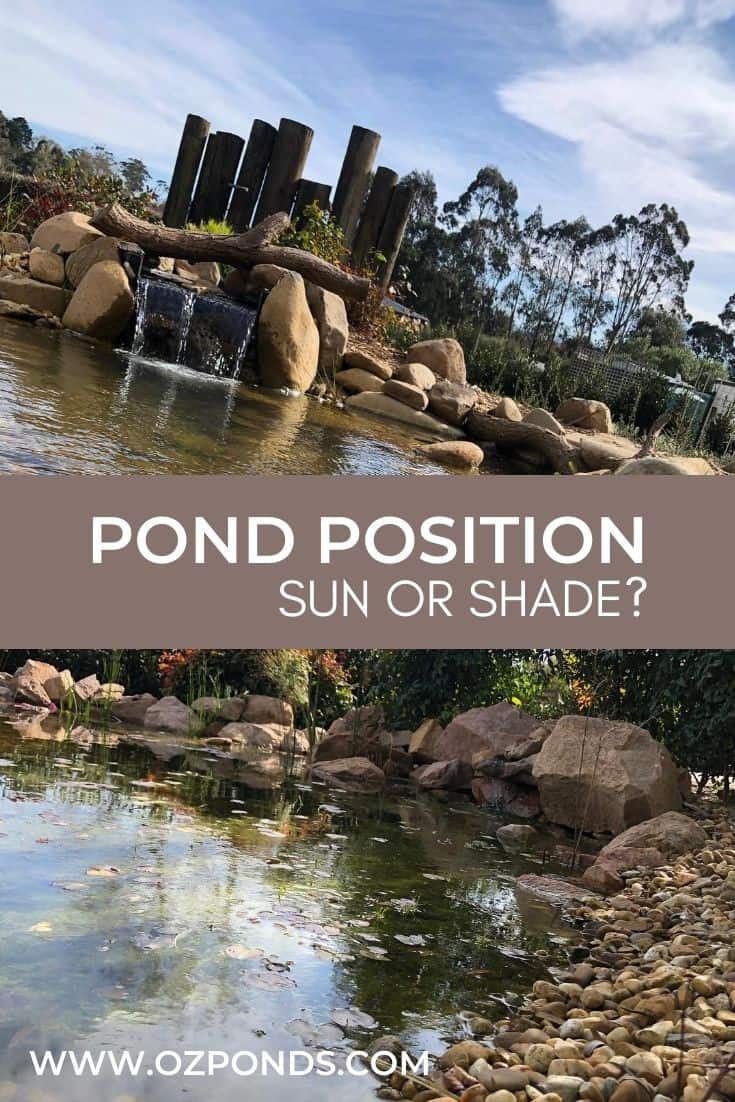The choice is entirely yours. A pond can be built in full shade, part shade, dappled shade, full sun, morning sun, afternoon sun or anywhere between.
Whether sun or shade both have advantages and disadvantages. It all depends on what you want from your pond.
When it comes to the position of your pond selecting a location where you’ll get the most enjoyment out of the feature should be front and foremost.
Advantages of positioning a pond in full sun
The main advantage of having a pond in full or part sun is you’ll have a wider choice of pond plants. Most flowering plants will prefer a certain number of hours of sunlight.
Water lilies for example will flower best if they receive at least 6hrs of sunlight per day. Hardy water lilies flowers only open during daylight.
Some people also say that their fishes colours are more vibrant when they receive sun throughout the day.
Disadvantages of Positioning a pond in full sun
The main disadvantage is algae is also a plant that loves sun. Ponds in full sun can be more prone to algae.
However don’t let this stop you from placing a pond in full sun if that’s the area of the garden where you’ll get the most enjoyment.
Solutions
Keeping the algae at bay is really simple provided you have good filtration. I prefer wetland/ bog filtration (click the link to read why it’s so good).
Provide adequate pond depth. This will allow the water to maintain a cooler temperature during the height of summer. Algae also loves warm water.
Use plenty of plants around the margins and within the pond itself.
Plants will consume nutrients within the water, thus robbing the algae of food. Also floating plants can provide pockets of shade, which will help keep the water cool.
Add oxygen. Warm water loses more oxygen than cold water.
Fish need oxygen to survive. During the height of summer it may be necessary to add an aerator to improve oxygen levels.
Using fast flowing streams or waterfalls entering the pond is a great natural looking way to increase overall oxygen levels.
Installing an ioniser. These release copper particles into the water.
These particles bond with the algae and kill it. These can be adjusted. Turned up when needed and down when not. They are cheap to run, although a little pricey to buy.
Advantages of positioning a pond in the shade
The biggest advantage a pond in the shade has is that it’s much harder for algae to grow. The most common types of pond algae are string algae and suspended algae. Both require sun to thrive.
A second advantage is the water temperature will stay more stable. During summer the shade will keep the water cooler. Whilst in winter the shade can help produce a microclimate where the temperature is slightly warmer.
Disadvantages of positioning a pond in the shade
Debris is the biggest disadvantage of a pond in the shade. The trees are going to drop leaves and twigs into your pond.
These can make a real mess and lead to a build up of sediment and decomposing material on the bottom of the pond.
If left to just break down naturally they can begin to stave the pond of valuable oxygen and increase the nutrient levels of the pond. Both of these are bad for our pond fish.
The second disadvantage is that your plant selection becomes more limited. There is certainly more plants available if your pond is in the sun.
Flowering plants particularly are not as easy to find for shaded areas. In particular water lilies will only produce leaves in the shade, no flowers.
Solutions
In regards to the debris that falls into the pond adding a pond skimmer or two will greatly reduce the amount of leaves and twigs that sink to the bottom of the pond.
Skimmers work in conjunction with your pond pump to create surface tension or current. This tension pulls all the floating debris into the skimmer basket. From here it’s just a matter of emptying as required.
Some of the debris will inevitably find its way onto the bottom. A regular scooping with a pond net will go along way to stopping the build up of muck on the bottom.
The action of string up the water also briefly kicks up a lot of muck and allows the skimmer to pull a lot of it in.
Another option is a good quality pond vacuum. These will siphon all the crap and allow the water to flow back into the pond. If you’ve got a good vac this is a job you should only need to do once a year.
As far as plant selection is concerned its not hard to find beautiful plants to place in and around your pond. While your water lilies won’t flower they are still a worthy addition to the pond as the leaves are still very pretty.
To add colour use nice foliage plants like lobelia and cannas both have striking vibrant foliage and are well suited to the margins of the pond.
For the gardens surrounding the pond adding things like hellebores, hostas, clivias and azaleas will provide plenty of colour even in a shady site.
Subscribe
Form time to time I receive special offers and discounts from pond product suppliers and distributors.
I love saving the readers money and are more than happy to pass these offers on to you.
If you would like to receives these special discounts, sign up to my mailing list using the button below.

